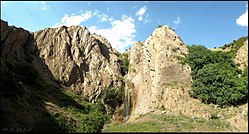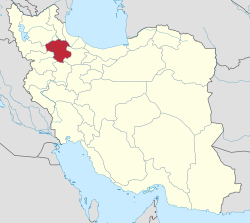|
Tarom County
Tarom County (Persian: شهرستان طارم) is in Zanjan province, Iran. Its capital is the city of Ab Bar.[3] HistoryThe region of Tarom is historically divided into two parts: Upper Tarom and Lower Tarom.[4] Medieval Arabic geographers usually wrote the name as aṭ-Ṭārumayn, or "the two Taroms", reflecting this division.[4] The mountainous Upper Tarom was historically counted as part of Daylam.[4] The name "Tarom" was applied to a right-bank tributary of the Sefid Rud, and the region of Tarom comprised the river and its own tributaries.[4] An important location in Tarom was the castle and town of Semiran, which lay in Lower Tarom on the main highway leading to Sarab.[4] The castle crowned a rocky mount above the lower town and had triple walls.[4] Ibn Muhalhal visited here c. 943 and wrote that it was one of the main strongholds of the Daylamite kings and had about 2,850 houses.[4] The Buyid amir Fakhr al-Dawla captured Semiran in 989 from the Vahsudan dynasty.[4] Al-Muqaddasi wrote about the same time that the fortress of Semiran had "lions of gold, and the sun and the moon" on its walls; the town's houses were built from mud brick.[4] He counted Semiran as part of the Salārvand district.[4] Nasir-i Khusraw visited Semiran in 1046 during his pilgrimage to Mecca; he described it as the capital of Tarom.[4] Its fortress, he wrote, was garrisoned by a thousand men and had an underground conduit to supply water.[4] By the time Yaqut al-Hamawi visited Semiran in the early 1200s, the castle had been slighted by the Nizaris, although the ruins were still impressive enough that Yaqut called it "a mother of castles".[4] Another fortress that Yaqut mentioned was Qilāt, located in the mountains on the Daylam frontier.[4] It was located atop a mountain and had belonged to the Nizaris of Alamut.[4] Below it was a town with "excellent" markets; there was also a masonry bridge with many arches crossing the stream.[4] In the Nuzhat al-QulubThe 14th-century author Hamdallah Mustawfi gave a detailed description of the two Taroms in his Nuzhat al-Qulub.[5] He described the two regions as fertile for agriculture – they supplied the city of Soltaniyeh with most of its fruit, he wrote – and populated mostly by Sunnis of the Shafi'i madhhab.[5] He wrote that a town called Firuzabad, which was in Lower Tarom, had formerly been the capital of the region, but by his lifetime Firuzabad had become "a complete ruin".[5] A place called Andar, which was in Upper Tarom, had replaced it as Tarom's capital.[5] Mustawfi described the two Taroms as being divided into five districts.[5] The first consisted of the dependencies of Qal'ah Tāj ("the crown castle"), which was in Upper Tarom.[5] He said this district included about 100 villages; the most important were Jazlā, Shūrzad, Darām, Ḥayāt, Qalāt, Razīd, and Shīd.[5] The second district was based around the castle of Semiran, in Lower Tarom.[5] This district had about 50 villages, with the most important being Alūn, Khawarnaq, Sharzūrlard, and Kalach.[5] The third district was based around the castle of Firdaws, also in Lower Tarom; this district comprised about 20 villages, with the most important being Sarvān.[5] The fourth district was based around, instead of a castle, two large villages: Nisbār and Barīdūn.[5] It consisted of 8 hamlets that were dependencies of the two main villages.[5] Mustawfi did not specified whether this district belonged to Upper or Lower Tarom.[5] The fifth and final district was Lower Dizābād; Mustawfi said nothing about this district's affiliation either.[5] In any case, it had 25 villages; the most important were Gulhār, Gulchīn, and Balhal.[5] The combined revenue of these five districts, according to Mustawfi, was 64,000 dinars.[5] Administrative changesIn 2017, Gilvan Rural District was separated from the Central District in the formation of Gilvan District, which included the new Tashvir Rural District.[6] The village of Gilvan was elevated to the status of a city in 2024.[7] DemographicsPopulationAt the time of the 2006 National Census, the county's population was 42,939 in 10,734 households.[8] The following census in 2011 counted 46,616 people in 13,221 households.[9] The 2016 census measured the population of the county as 46,641 in 14,438 households.[2] Administrative divisionsTarom County's population history and administrative structure over three consecutive censuses are shown in the following table.
GeologyTarom is part of the Tarom-Hashtjin Metallogenic Province, which is one of the most important epithermal regions in Iran.[10]: 1 Lead, zinc, copper, iron, and manganese are prevalent.[11]: 271 Compared to the Hashtjin part, copper and iron are more widespread in Tarom.[11]: 271 The average copper content of plutonic bodies ranges from 220 to 260 ppm.[11]: 271 Lead, zinc, and silver content are 600, 800, and 8 ppm respectively.[11]: 271 Gold deposits are found mixed in with some copper deposits, such as at Khalifeloo, Abbasabad, and Chargar.[11]: 271 There are also gold deposits at Asadi and Ghez Ghal'e.[11]: 271 Tarom also has relatively more alunite deposits than Hashtjin, including ones at Yuzbash Chay, Kamar Rud, Nasr Abad, Sirdan, Zajkan, and Zajkandi.[11]: 271 There are also minor tungsten deposits, such as at Kuhian.[11]: 271 Sericitization is less widespread in Tarom than in Hashtjin, and "greisen-type metasomatism" has not been reported in Tarom.[11]: 271 See also
NotesReferences
|
||||||||||||||||||||||||||||||||||||||||||||||||||||||||||||||||||||||||||||||||||||||||||||



